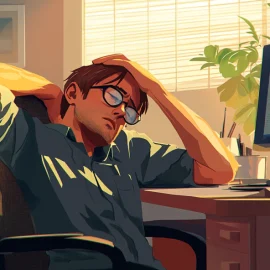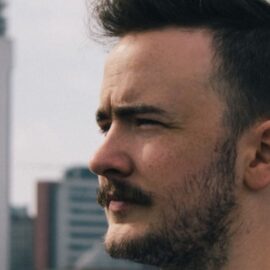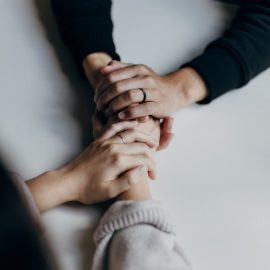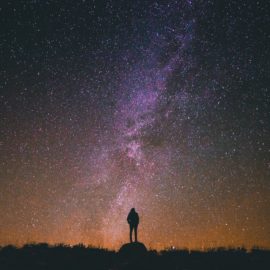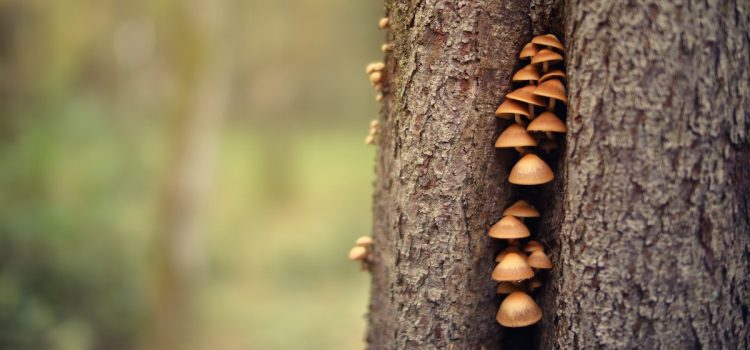
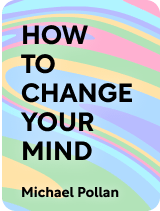
This article is an excerpt from the Shortform book guide to "How to Change Your Mind" by Michael Pollan. Shortform has the world's best summaries and analyses of books you should be reading.
Like this article? Sign up for a free trial here.
Where does the history of psychedelics begin? What did the Greeks do with psychedelics in the ancient world?
Psychedelics have been around for centuries, and have cultural and healing significance in indigenous cultures. It wasn’t until the 1950s that certain psychedelics spread to American and European cultures where they were criminalized and banned.
Let’s explore the rich history of psychedelics, as written in How to Change Your Mind by Michael Pollan.
The History of Psychedelics
We’ll begin our history of psychedelics with a definition. The word “psychedelic” means “mind manifesting.” Coined in 1957, it’s a relatively recent term, but humans’ relationship with these substances is hardly new. Psychedelics are sometimes referred to by anthropologists as entheogens, which is derived from the Greek “god within,” and they are also commonly called “hallucinogens.” Pollan explains that anthropologists and other scholars generally shun the latter term, however, because of its implication that the experiences caused by these substances are not real.
| What Are Psychedelics and How Are They Used? The term “psychedelics” is typically used to refer to chemicals or plants that have psychoactive (mind-altering) properties when ingested by humans. These substances can create profound changes in perception, thought patterns, and mood. Examples include psilocybin (found in “magic mushrooms”), LSD, DMT, ayahuasca, mescaline, and many others—some of which are synthetic while others occur naturally. Although psychedelics are generally safer than most other types of recreational drugs, they come with risks since they alter your perception. Users can have extremely negative “trips” that can have long-lasting effects on their mental health. This is why experts stress the crucial importance of context for psychedelic experiences. |
In this section, we’ll summarize the history of psychedelics, as Pollan explains it, in three phases:
- Psychedelics have a rich history of use in indigenous cultures for spiritual and healing purposes, dating back to ancient times.
- LSD and psilocybin made their way into American and European cultures in the 1950s. Their widespread recreational use in the 1960s, as well as some serious missteps with early psychedelic research, led to their criminalization and stigmatization for several decades.
- In recent years, research into the use of psychedelics for mental health treatment has been revived.
History of Psychedelics in the Ancient World
Humans’ relationship with psychedelics is longer than recorded history. Pollan tells us that indigenous cultures all over the world have developed unique relationships with natural consciousness-altering substances and have used them in healing and spiritual practices for thousands of years.
Archaeologists have found evidence of the use of psychedelic substances well into prehistoric times, and written documentation of their use goes as far back as ancient Greece. Some scholars believe the earliest Christian eucharist rituals in Greece were carry-overs from ancient Dionysian rituals revolving around a psychedelic brew. And cultures throughout Mesoamerica used mushrooms and other psychedelics in their religious practices.
But these practices would all come under attack by the Roman Catholic Church, first in ancient Greece and then later in the 16th and 17th centuries during the Spanish colonial conquest of the Americas. Pollan says Spanish priests who missionized the Aztecs in modern-day Mexico declared that the Aztecs’ consumption of mushrooms was a communion with the devil. These kinds of assumptions resulted in deliberate suppression of the use of psychedelics by native peoples, including the Aztecs—who used psychedelic mushrooms and morning glory seeds—and Native American tribes, some of whom use a psychedelic cactus called peyote. The Church quickly sought to eradicate these practices because they undermined the Church’s authority and threatened the spread of Christianity.
Despite repeated efforts by ruling powers to stamp out psychedelic use, Pollan says the ancient and enduring history of humans’ relationship with these substances suggests that they must serve important functions. Some scholars even suggest that psychedelics may be the most important historical driver of the development of religion and of the evolution of human consciousness.
History of Psychedelics in the Modern Western World
Next, we’ll take a look at the complicated role of psychedelics—most importantly LSD and psilocybin—in modern Western culture. As we’ll see, this too is a history fraught with tension between experimenters and authority figures, a conflict between freedom and control.
The Accidental Invention of LSD
Pollan explains that the history of LSD begins in a Swiss laboratory in 1938. A chemist named Albert Hofman was working on medical research that involved creating synthetic compounds from ergot, a toxic fungus that grows on grains. He identified an alkaloid in ergot called lysergic acid and began to create derivatives of it, looking for medical treatments for respiratory and circulatory ailments. The 25th derivative would be a revolutionary invention called lysergic acid diethylamide-25 (LSD-25).
Five years into his experimentation with these compounds, Hofman accidentally absorbed a minute amount of LSD-25 through his skin. He had the world’s first acid trip that afternoon, which he documented in detail, and this discovery had some extraordinary effects on the world.
As medical researchers learned about LSD in the 1940s and 50s, some believed the LSD experience sounded like it mimicked psychosis. This prompted psychiatrists to question whether mental illness might have a biochemical basis, whereas it had previously been understood to be purely psychological. Pollan explains that the effect this shift in thinking had on psychiatric research was revolutionary. Some psychiatrists even undertook personal experimentation with LSD, thinking it would allow them to better understand the experience of their psychotic patients and improve their ability to treat them. By the 1950s, research testing LSD on psychiatric patients was ongoing in medical centers and universities in Europe, America, and Canada.
Because researchers initially used LSD to intentionally induce temporary psychosis, they were surprised when, after more widespread experimentation, most subjects reported positive experiences. While some subjects reported paranoia and anxiety, many described feelings of transcendence, oneness with the world, heightened sensory experiences, and profound new philosophical or spiritual understandings. This led researchers to consider much broader applications for the drug, and it was eventually tested for treatment of a variety of conditions, such as depression, anxiety, obsessive compulsive disorder, and addiction (most notably alcoholism).
Psilocybin Takes Root in America
Along with LSD, Pollan tells us that Westerners were also discovering psilocybin mushrooms in the 1950s. In 1957, a researcher named R. Gordon Wasson published an article in the widely read Life magazine documenting his experience participating in a psychedelic ceremony with the indigenous Mazatec people of Mexico. Pollan explains that this article brought the potential of psilocybin to the attention of both researchers and mainstream America, where the adventurous youth began to seek it out enthusiastically.
Beginning in the 1950s and throughout the 1960s, prestigious American institutions like Harvard, Stanford, and MIT tested psychedelics on both volunteer subjects and themselves. Pollan tells us that more than 1,000 scientific papers were published on psychedelics during these two decades, and the substances were used with considerable success to treat a variety of mental health conditions.
The best-known psychedelic researcher of this era was Timothy Leary, who along with his colleague Richard Alpert, began running the Harvard Psilocybin Project in 1960. Over the next two years, Leary and Alpert would administer psilocybin to hundreds of student volunteers, in addition to taking it themselves. But Pollan explains that the lack of scientific control and rigor, as well as the fact that the experimenters were also under the influence, ultimately caused the experiments to be shut down.
Moral Panic Leads to the Banning of Psychedelics
Pollan tells us that the socio-cultural effects of psychedelic use—particularly LSD—in the counterculture scene were eventually perceived to be too disruptive to society, so the US government began to crack down on it. He says that President Richard Nixon once referred to Leary as “the most dangerous man in America.”
By the mid-1960s, propaganda focusing on the dangers of psychedelics—which Pollan says were mostly exaggerated or entirely fictitious—began to circulate heavily in the media, and a moral panic ensued. University researchers were ordered to cease experimentation with psychedelics in 1966, and by the end of the decade, the substances were made federally illegal. The Controlled Substances Act, passed in 1970, classified LSD and psilocybin as Schedule I substances, which means they’re deemed to have high potential for abuse and no recognized medical value, despite evidence to the contrary. They remain classified as such today.
Research on Psychedelics is Revived
After a decades-long ban, a few researchers attempted in the 1990s to resurrect interest in the study of psychedelics for mental health and spirituality. But it was only in 2006 that a new renaissance of psychedelic research was kicked off with another Johns Hopkins study. It was described in a paper titled “Psilocybin Can Occasion Mystical-Type Experiences Having Substantial and Sustained Personal Meaning and Spiritual Significance.” Pollan tells us that this work made a few crucially important contributions to the history and understanding of psychedelics:
- It opened up a new dialogue and interest in the scientific study of psychedelics.
- It started a conversation about the distinction between psychedelics and other types of “drugs,” leading to a wider recognition that psychedelics are generally much safer, have therapeutic use, and are non-addictive.
- It bridged a gap between science and spirituality. This study looked at the spiritual experiences of healthy participants, acknowledging that psychedelic experiences can have inherent value for humanity as a whole, not just for treatment of illness.
(Shortform note: Several similar studies have been conducted since the 2006 Johns Hopkins one, with consistent results. A 2011 study showed that while 39% of volunteers experienced extreme anxiety or fear while taking the drug, 72% reported having mystical experiences. At follow-ups one month and 14 months later, volunteers said that these experiences had substantial personal and spiritual significance, and they reported sustained positive changes in mood, attitudes, and behaviors.)

———End of Preview———
Like what you just read? Read the rest of the world's best book summary and analysis of Michael Pollan's "How to Change Your Mind" at Shortform.
Here's what you'll find in our full How to Change Your Mind summary:
- The long and complex history of humans' relationship with psychedelics
- Psychedelics' potential use for mental health treatment today
- Why there are so many cultural and legal issues surrounding psychedelics


